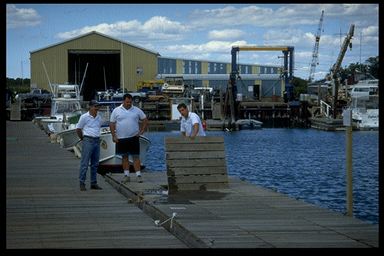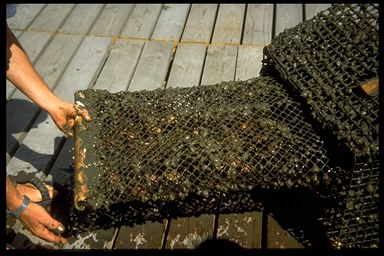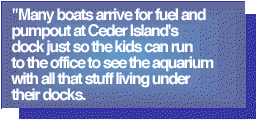
6. Cedar Island Marina, Inc.
Marina Habitat Assessment and Scallop Farming
| Location: | Riverside Drive, P.O.Box 181, Clinton, CT 06413 |
| Telephone: | (860) 669-8681, fax: (860) 669-4157 |
| Interviewed: | Jeffrey Shapiro, President |
| Owned by: | Shapiro Family Trusts |
| Waterbody: | Clinton Harbor, Long Island Sound |
Environmental change
Ten years of private ecology research has demonstrated that recreational boat full-service marinas are productive artificial reefs and has led to the development of commercially viable bay scallop aquaculture under marina docks.
The full-service marina, boatyard, and fish farm
Cedar Island Marina is a family-owned business that calls itself "the family boating resort." It is a full-service marina/boatyard with 400 slips operating at 94% capacity in 1995, with many transient visitors filling slips vacated when homeport vessels are away. Three boats are year-round liveaboards. Boat sizes range from under 21 feet up to 120 feet, with 76% between 21 and 35 feet, and 19% longer; 35% are sailboats.
Cedar Island has a staff of 25 year-round employees, which expands to 50 full-timers during the boating season. In addition to slips, the marina has retail services: ship's store, grocery, ice, bait/tackle, used boat brokerage, fuel dock, and pumpout. Launch/haulout is available with a 30-ton travel lift and "giraffe" crane for indoor and outdoor winter boat storage. Full repair services include fiberglass, hull, and engine repair; painting; sail rigging; sail making; welding/metal fabrication; and bottom cleaning.
Located in Clinton Harbor, one of the few protected harbors (in southern New England) not burdened with industry, the resort-like marina is 1 mile from the entrance buoy to Long Island Sound and borders the Hammonasset Nature Preserve. Its customer amenities include a laundry, 60-foot swimming pool, sauna, whirlpool, picnic grounds, saltwater beach, snack bar, 275-seat restaurant, poolside bands, night security, cable TV, and a children's activity director. On a busy summer weekend approximately 40% of the boats are in use, occupied, or under way out of the harbor; about 20% of the boats have people sleeping overnight.
Within a 2-mile radius, there are 8 other marinas and boatyards with an estimated total boat population of 2,000. The prime boating season starts in May and ends in October. Cedar Island Marina was bought by the Shapiro family in 1974 and converted from a fuel terminal built in 1964. Jeffrey Shapiro is also a general partner in the Clinton Harbor Boat Show each July-another major focus of attention, publicity, and potential customer draw to his marina.
Management measures
Cedar Island Marina complies with the marina management measures for water quality assessment and habitat assessment, as well as marina flushing, shoreline stabilization, storm water runoff control, fueling station design, sewage facility, sewage facility maintenance, solid waste, liquid materials, petroleum control, and public education.
Costs/benefits
In 1995, Cedar Island Marina spent $38,500 to staff and operate its private marina research laboratory, including two full-time marine biologists. Its aquaculture project and public display aquariums attracted new boating families into slips for the season and helped retain other customers, resulting in an estimated $46,000 gross slip income. The special docks designed by Cedar Island for the aquaculture project cost the company no more than conventional docks. Marina management estimates that the aquaculture project brings them around $5,000 worth of publicity each year and has extended their dredging season, saving another $5,000 annually.
Environmental improvements
When the State of Connecticut turned down Cedar Island Marina's request for an additional 396 slips in 1988 because the expansion would be "destroying valuable marina life and habitat," little did anyone realize what positive effects would result after Jeffrey Shapiro accepted the challenge. "We decided to prove Connecticut wrong because I was convinced that the marina would improve-not destroy-the harbor's habitat. So I began hiring environmental consultants to test what was happening in and under the marina waters here." That effort has turned into a full-time marina ecology research laboratory with two full-time scientists. Thirteen technical reports were published and/or presented at professional estuarine, fisheries management, and Long Island Sound conferences between 1989 and 1995.
| With removable center panels, marine biologists check to growth of scallops in traps suspended below the Cedar Island Marina's floating docks. |  |
The Cedar Island Marine Research Laboratory is entirely owned, operated, and funded as part of Cedar Island Marina. Its laboratory and in-water field station are also in the marina. Studies have included assessment and long-term monitoring of water quality (temperature, salinity, dissolved oxygen), marina habitat, coastal birds, and finfish communities (particularly juvenile winter flounder, Pseudopleuronectes americanus) in the marina, as compared to other natural habitats in Clinton Harbor.
"Testing has proven that our marina's waters have good oxygen levels and lower coliform counts than those at the town beach. And heavy metals did not accumulate in scallops growing on the marina bottom," Jeffrey Shapiro stated. "Also the periwinkle snails-a favorite food of winter flounder-are 20 times more abundant on the marina's dredged bottom than on the neighboring mud flats, which helps explain why we have a 10-times larger population of baby flounder under our docks than elsewhere in the harbor."
Studies in recent years-performed in cooperation with the marine laboratories of the U.S. Fish and Wildlife Service, Connecticut Department of Environmental Protection (DEP), and Connecticut Sea Grant-have focused on the marina habitat with special emphasis on its finfish nursery and shellfish aquaculture potential.
Noticing that many marine species grew more rapidly and remained healthy under marina docks and boats, Shapiro's lab staff started growing shellfish on trays suspended below the floating docks. Indeed, they grew faster than those placed in neighboring natural marsh flats and were just as safe for human consumption. Oysters, it was determined, could be grown to market size 1 year quicker under boat docks than outside the marina basin. (Note: Cedar Island's research under marina docks is consistent with that done by others on hard-shell clams in Rhode Island and finfish in Washington.)
But two key factors inhibited use of marinas for oyster farming. First, U.S. Food and Drug Administration standards require the filter-feeding oysters to be relocated to "clean" waters for several months of depuration before being eaten, and that extra handling is costly. Second, oysters take 4 years to grow to market size. Shapiro switched to another shellfish-bay scallops-and seems to have solved those problems.
In the spring of 1995, with some Connecticut Sea Grant funds and in-kind technical help from state and federal marine biologists, Cedar Island Marine Research Laboratory bought 6,000 baby bay scallops, each about the diameter of a pencil (measured as 1,000 per liter). The scallops were distributed inside plastic mesh bags placed into three-level wire cages hung beneath special 60-ft floating aquaculture docks designed and built by Cedar Island Marina. Deck trap doors open to allow access to each shellfish cage for easy removal. Every 4 weeks, each cage is pulled. The mesh bags are opened, and the scallops are counted, measured, lightly brushed to remove fouling growth, and separated into more bags, but with fewer scallops per bag to allow expanded growing space.
By late September, all the scallops had grown to market size averaging 3 inches each. Asked what the mortality rate had been, research manager Matthew Mroczka answered, "I expected about a 30% death rate, but so far have lost 4-not percent-only 4 scallops, leaving 5,996 still alive and growing!" Aquaculture typically has higher survival rates than those in nature, often because of protection from predators, but Cedar Island's demonstration is truly remarkable.
"Now for the good part of why scallops are better than oysters here," said Shapiro. "When most shellfish are eaten, we consume all the meat and stomach, including whatever the animal's last meals included. But we only eat the large muscle of the scallop with the stomach thrown away. So the concerns about water quality do not apply the same way for scallops. Second, the scallop lives only one year from seed to maturity. So producing shellfish for market is largely done during one boating season."
"Today, each 3-inch scallop retails at 50¢, so if we sold this year's crop, we would gross $3,000. However, because the seed, costing $72, was paid for with a federal grant, we will turn them over to the University of Connecticut. But we will keep some of the biggest ones (which grew fastest) to become our breeding stock for 1996. And we will expand the number of scallops and cages. We are happy with it," Shapiro said. "Next year we're going to make money on it in a business way. And each year we'll select our fastest-growing scallops as breeders for the next generation, much as farmers select their best seed and animals for breeding."
"For 30 years there has been no commercial scallop fishery in the state. But within specially designed docks at Cedar Island Marina could be the seeds of a reborn commercial fishery."-The Hartford Courant, September 23, 1995.
Other benefits
Another clear business benefit derived from the lab work is that Cedar Island Marina is permitted to do its annual dredging, to maintain -8 feet MLW, during non-winter months. (All other marinas on Long Island Sound are limited to dredging in bitter cold months.) "Our environmental database, particularly the juvenile winter flounder data, helped convinced the state to extend our marina maintenance dredging season beyond the February 1 deadline to June 1, which gives a $5,000 cost saving by spot dredging in warmer weather."
| Aquaculture wire mesh traps protect scallop seed from predaors and hold multi-levels of trays |  |
This unusual marine research laboratory, owned and operated by a private commercial
full-service marina, is unique in the world. Shapiro admits that it is unlikely that
most other marinas could afford such a sustained scientific effort. "I learned
that it was more cost-effective to hire full-time biologists rather than hiring consultants
at $100 per hour. We've been spending over $30,000  annually for 5 to 6 years, and are now only really starting
to see a [business] return." But the Cedar Island Marine Research Laboratory's
published reports will benefit the entire marina industry internationally for many
years.
annually for 5 to 6 years, and are now only really starting
to see a [business] return." But the Cedar Island Marine Research Laboratory's
published reports will benefit the entire marina industry internationally for many
years.
To demonstrate the marine life diversity in the boating facility, the lab staff stocks and maintains a 400-gallon saltwater aquarium in the marina office. It is a major attraction for children and parents. "Many boats arrive for fuel and pumpout at Cedar Island's dock just so the kids can run to the office to see the aquarium with all that stuff living under their docks," Shapiro said proudly. "We set up a large marine touch tank during the Clinton Harbor Boat Show in late July. There were 5,000 people visiting the show, and our tank was the biggest attraction in the exhibit. It really impacts boater behavior not to throw trash or oil overboard. It also attracts visitors who heard about our aquarium. We get a chance to educate people about our environment."
"We got a $3,000 pumpout grant to add a second portable pump and 250-gallon holding tank for our fuel dock," Shapiro said. "We use a large 3-inch-diameter diaphragm pump and hose to give us greater suction and faster speed. We charge $5.00 for a pumpout done by our dockhands, but it is free for our slip renters. As a staff incentive, at the end of the season each year I recognize the staff member who did the most pumpouts with a personalized 'Pumpout King Award' and his/her name added to the plaque hanging in the fuel dock office. I started this in 1989 at the suggestion of two dock boys who were competing to get the most pumpouts that summer. The winner that year is listed first, then the other returned in 1990 determined to win-and he did-so his name is second. They like the competition." Asking every boat at the fuel dock to have a pumpout is part of the staff's written job description.
Also at the fuel dock, "An oil absorption boom, attached to a painter extension pole, lays on one end of the dock. Whenever a small spill occurs during fueling, the dockhand grabs the pole and pulls the 30-foot boom over the petroleum and moves it around until all the spill is absorbed, much like a mop would."
Waste oil and batteries are collected at the service area for recycling. This gives people a convenient place to bring their used oil, instead of throwing it into the dumpster or on the ground.
Gravel permeable parking and work areas help control runoff pollution. Landscaping in the public areas around the stores, pool, and restaurant makes a nice, clean marina atmosphere for boaters.
http://www.epa.gov/owow/NPS/marinas/ch6.html
This page last updated October 4, 1999


